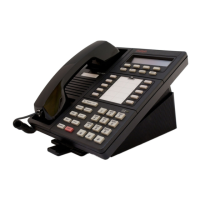MERLIN LEGEND Communications System Release 6.1
Feature Reference
555-661-110
Issue 1
August 1998
Features
Page 192CTI (Computer Telephony Integration) Link
Power Dial
Power Dial is an application feature where software on a user’s computer initiates
a voice call on a specified telephone to an inside or outside number. It is generally
used by people who must make a large volume of calls to individuals whose
telephone numbers are stored in a customer or client database. For example,
Power Dial is often used by for telemarketers and fundraisers.
Basic Call Control
A CTI application on your PC can control an extension’s SA button operations. No
other buttons (for example, personal lines) are monitored by applications or are
allowed to perform the CTI services. Basic call control includes:
■ Answering calls arriving on an SA button
■ Making calls from an SA button
■ Hanging up calls
■ Hold and retrieving a call on hold at the user’s extension
■ Inside transfer
■ Three-party conference, including those conferences where one or two
parties are outside the system
NOTES:
1. In Release 6.0 and later systems, a conferee in the non-local dial
plan is considered to be outside the system.
2. In Release 6.0 and later systems, if a PassageWay Telephony
Services client extension with a call on an analog Centrex
loop-start line attempts either to conference or to transfer to an
extension with Centrex Transfer via Remote Call Forwarding
activated, the call is immediately transferred without
consultation, regardless of the user’s intentions. The originator is
disconnected.
CTI applications vary in how they use the system’s features. The list of basic call
control activities includes the functions that a CTI application
may
control; a given
application does not
necessarily
use these system features.
DLC operator extensions can use CTI applications, although QCCs cannot. If a
DLC’s SA button operations are controlled by a CTI application, caller information
is passed on to a three-way conference or transfer destination, as long as the
operator uses the application to perform the transfer or conference. (The DLC
extension works as any other screen-pop-capable extension does.) If a DLC
operator’s SA calls are
not
controlled by a CTI application, then caller information
for transferred or conferenced calls is also passed on to a screen-pop-capable
extension, just as with a QCC. The only exception occurs when a call is
transferred from a Cover button on a DLC. In this case, there is no screen pop at
the destination extension.

